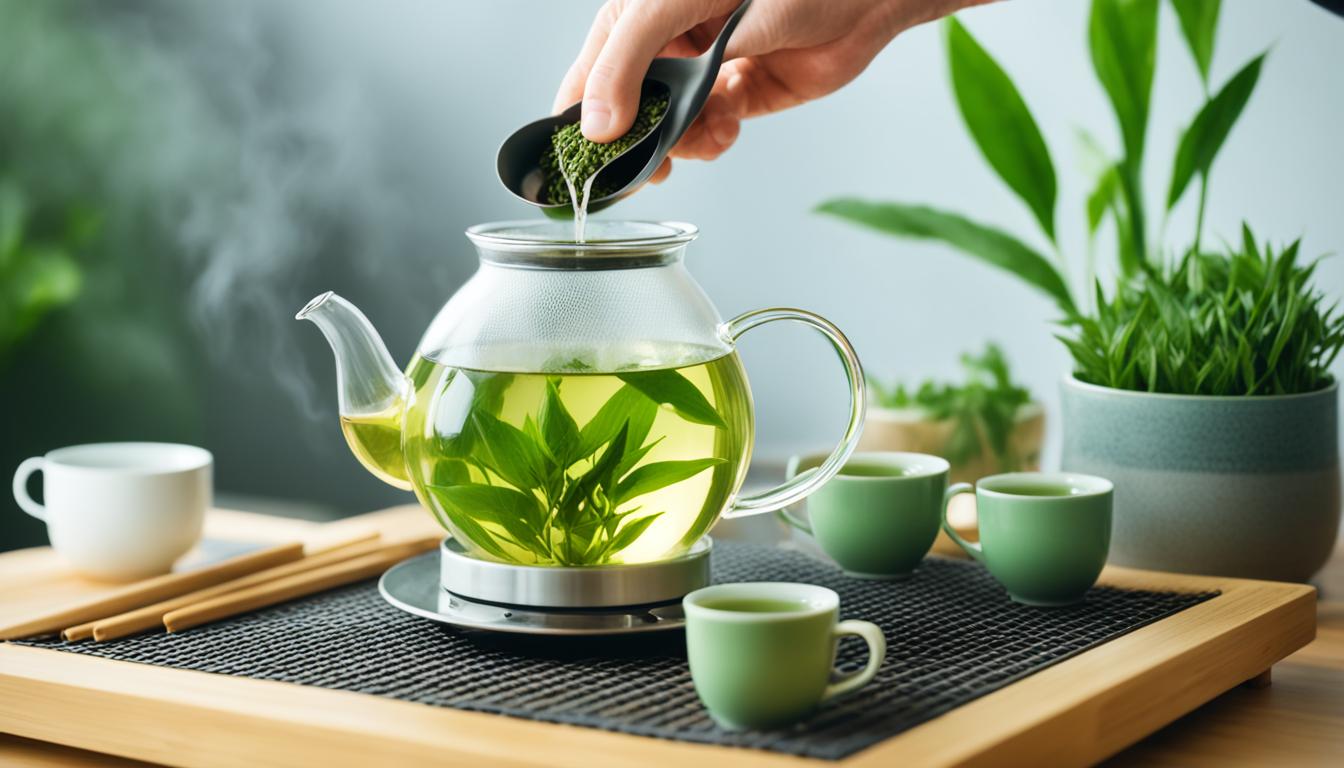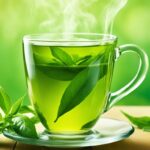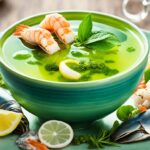Welcome to the serene world of green tea—a realm where time slows, senses awaken, and wellness begins with a simple sip. The art of brewing a cup of this verdant elixir can be both a tranquil meditation and a joyous celebration of flavor. For those seeking to master the basics of brewing green tea, this guide is the first step on an enlightening journey. Whether you’re a seasoned aficionado or new to the traditional brew, our step-by-step guide to brewing green tea aims to infuse your day with a touch of tranquility and a taste of perfection. Embrace the heritage of this ancient potion as we unfold the secrets to crafting the ultimate cup, one leaf at a time.
Key Takeaways
- Understanding the nuances of high-quality green tea selection
- Discovering the optimal water temperature and steeping times
- Exploring the essentials tools for a seamless brewing process
- Learning to adjust brewing variables for taste personalization
- Embracing the traditional roots and modern twists in green tea brewing
Introduction to Green Tea & Its Benefits
Beyond its enchanting aroma and subtle flavors, green tea has been a cornerstone of wellness rituals for millennia. Steeped in history, it is not just a beverage but a health-promoting elixir. Understanding the art of green tea brewing techniques is more than a pathway to a delightful cup; it’s an exploration of the myriad of green tea benefits waiting to be unlocked.
Green tea’s prominence in health circles is largely due to its high concentration of antioxidants, particularly catechins like EGCG, which are known to combat inflammation and support heart health. From sharpening mental focus to assisting in weight management, the attributes of green tea extend well into the domains of lifestyle and longevity. For the enthusiast keen on harnessing these advantages, knowing how to brew green tea correctly is essential.
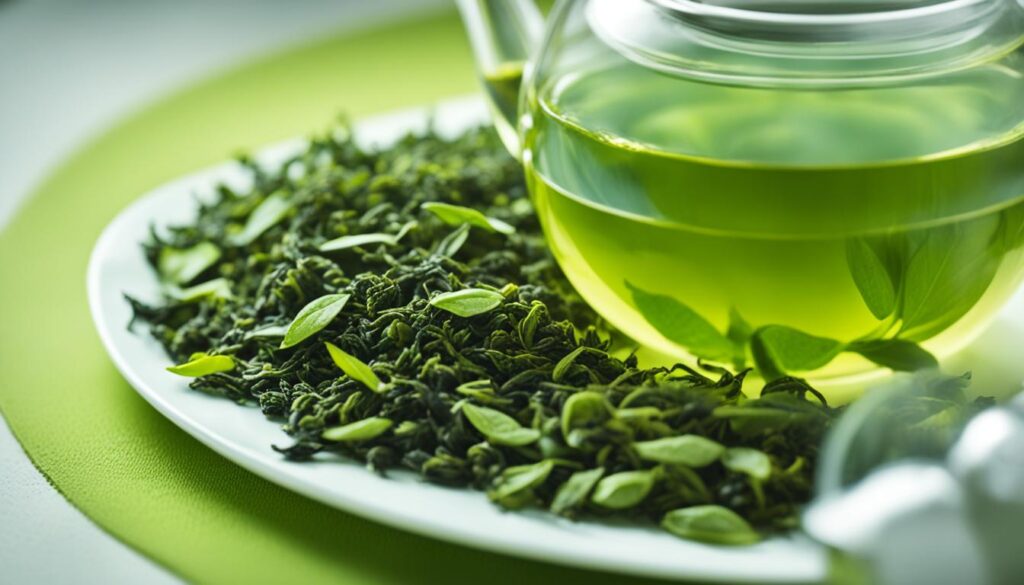
Each sip offers a world of possibilities for wellness, a testament to green tea’s versatility. Below is a comparative analysis of the significant health benefits associated with green tea, illustrating the potential impacts of this remarkable plant on our overall well-being:
| Health Benefit | Description | Green Tea Compound |
|---|---|---|
| Antioxidant Power | Neutralizes harmful free radicals, slowing the aging process and protecting against chronic diseases. | Epigallocatechin Gallate (EGCG) |
| Weight Management | Enhances metabolic rate and increases fat oxidation, aiding in weight loss efforts. | Caffeine and Catechins |
| Heart Health | Improves cholesterol levels and blood pressure, reducing the risk of heart disease. | Flavonoids |
| Mental Clarity | Improves cognitive functions and may reduce the risk of neurodegenerative diseases. | L-theanine and Polyphenols |
| Stress Reduction | Promotes relaxation without drowsiness, courtesy of its amino acid content. | L-theanine |
Awareness of these health boons offers a compelling incentive to perfect your green tea brewing practice. Embrace the serenity that comes with this timeless ritual, and allow the wholesome goodness of green tea to permeate your life—one steep at a time.
The Basics of Brewing Green Tea
Embarking on the green tea brewing process is an experience that balances simplicity and precision. A sublime cup of green tea is a culmination of factors done right—from the temperature of the water to the steeping time.
Green Tea Brewing Temperature
The ideal temperature is vital in coaxing out the subtle flavors without introducing bitterness. Generally, green tea unfolds best at temperatures between 150°F to 180°F (65°C – 80°C). Brewing green tea at the correct temperature ensures the tea’s delicate flavors are fully expressed.
Green Tea Steeping Time
Respect for the steeping time is equally critical. Typically, green tea should steep for 1 to 3 minutes. Longer steeping can lead to over-extraction and a bitter taste, while too short might result in a weak and underdeveloped flavor.
Green Tea Brewing Accessories
To achieve these precise conditions, an array of green tea brewing accessories can be employed. A kettle with temperature control is a key tool in your tea brewing arsenal, while an infuser or a traditional teapot can affect the quality of the steep.
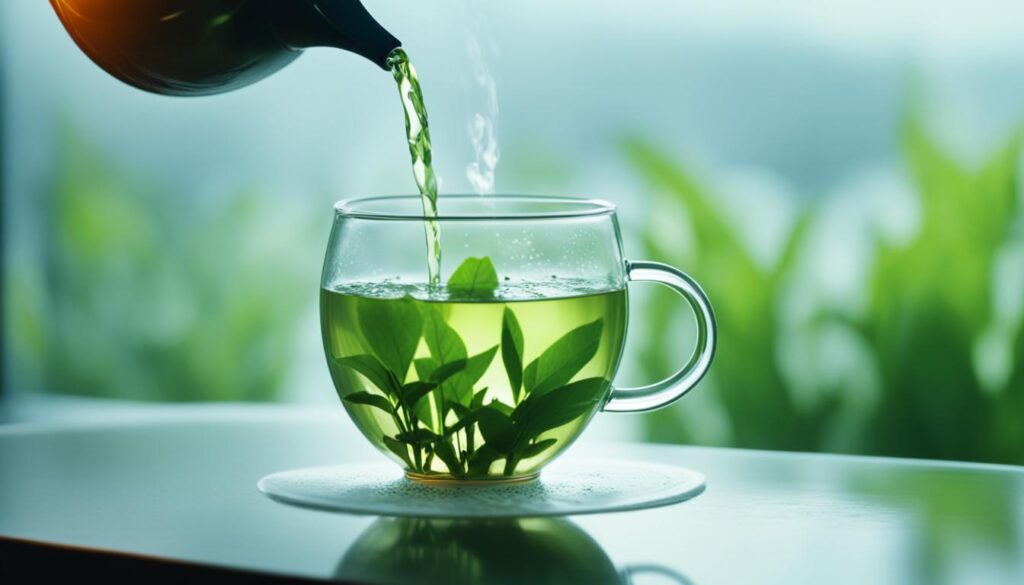
Utilizing these elements effectively translates to a ritual that is both artful and scientifically grounded. Below is a guide that combines all these critical factors:
| Brewing Step | Details | Recommended Accessories |
|---|---|---|
| Heat Water | Bring water to the correct temperature range (150°F – 180°F). | Kettle with temperature gauge |
| Prepare Tea | Measure out approximately 1 teaspoon of green tea per 8 oz of water. | Teaspoon, measuring tools |
| Steep Tea | Infuse the tea leaves for 1 to 3 minutes, adjusting based on desired strength. | Timer, teapot with infuser |
| Savor | Enjoy the tea, noting the depth and nuances of the flavors. | Ceramic or glass cup to appreciate color |
With these guidelines in mind, take delight in each step of the green tea brewing process and savor the moment. Each cup is a reflection of both tradition and personal preference—a testament to the joy of tea appreciation.
Adjusting Green Tea Brewing for Maximum Flavor
Mastering the art of green tea brewing goes beyond just knowing the fundamentals; it requires a touch of finesse and a willingness to experiment. Whether you’re seeking a robust flavor or a mellow sip, the control lies in your hands. Refining your brewing process to achieve the perfect green tea flavor can be rewarding and elevates your tea experience to new heights. Here are some tips for brewing green tea and best practices to enhance your daily cup.
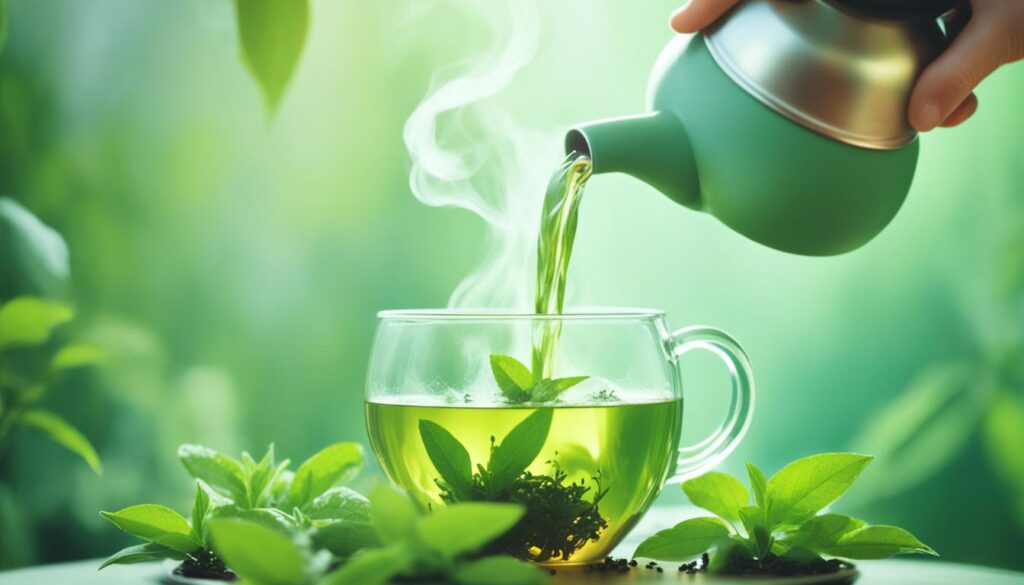
Let’s explore some variables you can adjust to customize your green tea’s flavor profile:
- Water Temperature: Green tea thrives in slightly cooler water. Think about aiming for a temperature range between 150-180°F (65-80°C) to avoid the bitterness that comes from overheating.
- Leaf-to-Water Ratio: A general guideline is one teaspoon of tea leaves per six ounces of water. Feel free to tweak this ratio based on whether you desire a stronger or subtler taste.
- Steeping Time: Start with a steeping time of one to three minutes. Longer steeping allows deeper extraction but risks developing a bitter edge, so it’s essential to find your preferred balance.
Remember, the magic is in the details. Here’s how gently varying different parameters can alter the final brew:
| Variable | Adjustment | Taste Outcome |
|---|---|---|
| Water Temperature | Increase | Bolder, more astringent |
| Water Temperature | Decrease | Smoother, delicate sweetness |
| Leaf-to-Water Ratio | More Leaves | Richer, more potent brew |
| Leaf-to-Water Ratio | Fewer Leaves | Lighter, more refreshing drink |
| Steeping Time | Longer | Intense, sometimes bitter |
| Steeping Time | Shorter | Mild, often more aromatic |
Best practices for brewing green tea involve patience and attention to these variables, but they also include using fresh, filtered water and storing your tea leaves properly to preserve freshness. Green tea is sensitive to its environment, and these details are just as crucial in achieving that elusive, perfect green tea flavor.
In conclusion, aspire to make each cup an intentional act of creation. Your perfect brew is waiting to be discovered through careful experimentation and a deep understanding of how the elements of brewing work together in harmony.
Conclusion
The artistry of perfect green tea brewing lies not merely in the elegant dance of leaves and water but in the joy of the journey itself. We’ve traveled a path that began with the foundations and proceeded to the mastery of time and temperature. Through every step of this guide, the goal was to simplify the process while retaining the nuance, ensuring that every sip carries the depth of tradition and the freshness of innovation. Embrace this inspirational green tea journey as not just a routine but a passage to tranquility, an exercise in mindfulness enriched by the heritage of centuries.
The pursuit of green tea mastery is an ongoing exploration of taste and refinement. With each cup, there’s an invitation to experiment—to play with the variables that transform ordinary green tea into an extraordinary experience. Whether you’re seeking solace in the morning’s gentle warmth or the afternoon’s reviving zest, let this guide be the compass that leads you to your ideal brew. Each element from leaf to cup is a note in an aromatic symphony, waiting to be conducted by your hand.
As we conclude this guide, remember that the simple acts of measuring, steeping, and savoring are not just steps but rituals that celebrate the vibrant, evolving spirit of green tea. So, continue to craft, to savor, and to share the story that every steaming cup unfolds. Here’s to the next pot, the next pour, and the boundless serenity to be discovered in a leaf’s gentle unfurling. Your cup of green tea is not just a drink; it’s an echo of ancient culture, a moment of peace, and a testament to the delight found in life’s simple pleasures.
FAQ
What are the essential steps to mastering the basics of brewing green tea?
To master the basics, start by selecting high-quality green tea leaves. Heat water to the right temperature, usually between 150°F and 180°F, and steep the leaves for a precise duration, which ranges from 1 to 3 minutes. Finally, pour and savor the nuanced flavors of your freshly brewed green tea.
Why is the brewing temperature so important for green tea?
The brewing temperature is critical for green tea because too hot water can scorch the leaves, leading to a bitter and astringent taste. The right temperature allows the delicate flavors and aromas to fully develop without the bitterness, resulting in a smooth and enjoyable cup.
How long should I steep green tea for the best flavor?
Green tea should generally be steeped for 1 to 3 minutes. Short steeping times yield a milder taste, while longer steeping will produce a stronger, more potent flavor. It’s important to experiment to find your personal preference and to consider the type of green tea you’re brewing. Note that, certain types like Gyokuro may require less time, while others such as Sencha might benefit from a bit longer steep.
Can you explain the health benefits of green tea?
Green tea is packed with antioxidants, particularly catechins, which may help in reducing inflammation, improving heart health, and aiding in weight management. It is also associated with improved brain function, a lower risk of certain cancers, and may be beneficial for skin health. The calming amino acid L-theanine in green tea can also provide a relaxed alertness.
What accessories are useful in the green tea brewing process?
Useful accessories include a ceramic or glass teapot, a kettle with temperature control, a tea infuser or strainer, and a timer to ensure accurate steeping time. Some enthusiasts prefer using a bamboo whisk and bowl for preparing matcha, a powdered form of green tea.
How can I adjust the brewing technique to enhance the flavor of green tea?
To enhance the flavor, adjust factors such as the water temperature, the tea-to-water ratio, and the steeping time. Water quality can also greatly impact the taste, so using filtered or spring water is suggested. Tasting and adjusting these elements will help you craft the perfect cup of green tea to your liking.
What is the ideal temperature for brewing green tea?
The ideal temperature for brewing most green teas is between 150°F and 180°F. However, the exact temperature can vary based on the type of green tea—delicate green teas can require lower temperatures, while more robust ones can tolerate slightly higher temperatures.
What’s the recommended ratio of green tea leaves to water?
A standard guideline is to use about 1 teaspoon of green tea leaves for every 6 to 8 ounces of water. This can be adjusted according to the strength of flavor you prefer. For a more intense flavor, add more leaves; for a milder cup, use fewer leaves.

